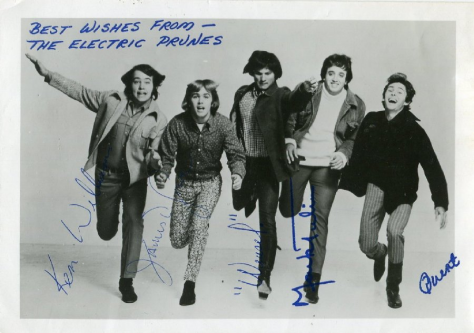
For those not in the know, fan albums are the attempts of me and many others to take songs and put them on an album, typically they’re made to improve upon something, such as an existing album or to take non-album tracks and put them on an album.
Despite my mixed views on psychedelic bands, The Electric Prunes stand as a very quality example of the genre. While they had five albums before their 1990s reunion, that’s not nearly as appealing as it seems. After the third album, the entire band quit and was replaced! Thus, the last two don’t feature the real Prunes at all. Even the third features the band more minimally, with guitarist Ken WIlliams not on every track. The group’s singer only counts the first two of those albums as being kosher. I wanted to see if I could get a fourth (or third) “true” Prunes album from the 60s. In terms of stray tracks, there seemingly was a gold mine of high fidelity demos from 1965. However, the first session, which yielded a perfect twelve recordings, don’t have perfect sound quality and more importantly, aren’t that good of performances, nor do they have the band’s classic psych sound. After a little bit of fire in the beginning, the momentum of the thing kind of dies out. It’s not the worst thing ever, but not that interesting. I don’t even like to think of it as a real Prunes album. I do have a soft spot for teenage garage bands for all their faults. They can’t all be first lineup Kingsmen.
The Sanctions (1965) – Spotify
TRACKLISTING
SIDE A
- “Boys”
- “Long Tall Sally”
- “Moon Dog”
- “Somethin’ Got A Hold On Me”
- “Money”
- “Love Potion Number Nine”
SIDE B
- “Jack The Ripper”
- “New Orleans”
- “What’d I Say”
- “Chicago”
- “You Can Help Yourself”
- “Louie Louie”
PERSONNEL
- James Lowe – lead vocals, guitar
- Ken Williams – lead guitar
- Mark Tulin – bass
- Michael “Quint” Weakley – drums
After this, there was another demo session that I liked more, feeling like the halfway point between the first twelve recordings and the classic sound. The main issue is the low audio quality being worse than the studio songs. There’s also a few studio strays before the first album and then later on a few after the second album, which I really like. I originally was going to make an album of either every stray track after The Sanctions or at least those in between that and the first album, but problem is they don’t gel together at all. Even if I was to collect them, they’d be a very short twenty-four minutes. Thus, I like to think of them as being released as a series of EPs. Down the line, what if they were released as a compilation called 3Ps?
The Electric Prunes – I’m Free (1965) – Spotify
TRACKLISTING
SIDE A
- “I’m Free”
- “I’m Down”
SIDE B
- “Too Many People”
BONUS TRACK
- “Little (Li’l) Olive”
PERSONNEL
- James Lowe – lead vocals, guitar
- Ken Williams – lead guitar
- Mark Tulin – bass
- Michael “Quint” Weakley – drums
- Dick Hargrave – keyboard
The Electric Prunes – Ain’t It Hard And Three More (1966) – Spotify
TRACKLISTING
SIDE A
- “Ain’t It Hard”
- “Little Olive”
SIDE B
- “World of Darkness”
- “I’ve Got a Way of My Own”
PERSONNEL
- James Lowe – lead vocals, guitar
- Ken Williams – lead guitar
- Mark Tulin – bass
- Michael “Quint” Weakley – drums (tracks 1-2)
- James “Weasel” Spagnola – rhythm guitar (tracks 3-4)
- Preston Ritter – drums (tracks 3-4)
The Electric Prunes (1967) – YouTube, Spotify
The Electric Prunes – Underground (1967) – YouTube, Spotify
The Electric Prunes – Shadows (1967) – Spotify
TRACKLISTING
SIDE A
- “Everybody Knows (You’re Not In Love)”
SIDE B
- “You Never Had It Better”
- “Shadows”
PERSONNEL
- James Lowe – lead vocals, guitar
- Ken Williams – lead guitar
- Mark Tulin – bass
- Michael “Quint” Weakley – drums
- Mike Gannon – rhythm guitar
The Electric Prunes – Stockholm 67 (Recorded 1967) – YouTube, Spotify
The Electric Prunes – Mass in F Minor (1968) – YouTube, Spotify
The Electric Prunes – Artifact (2001) – YouTube
The Electric Prunes – Rewired (2002) – YouTube, Spotify
The Electric Prunes – California (2004) – can’t find
The Electric Prunes – Feedback (2006) – YouTube, Spotify
Without Ken Williams:
The Electric Prunes – Return To Stockholm (2012) – can’t find
The Electric Prunes – WaS (2014) – can’t find
Thus, I frankly can’t make a real “fourth Prunes album”. At best we have a few strays which admittedly are sometimes great. As a consolation prize, there is the live album and also a reunion career which originally featured the three main members of the band. Two of them have since left. I haven’t really taken any look at the reunion era. I will say I know there are at least some strays from then, but I don’t know much about them.
“Oh by gee, by gosh, by golly. Life to him was oh so jolly. Dad, what happened to the Toonerville Trolley?”
This is a passion of mine and if one person likes what I do, I’ll feel honored. I like suggestions on what artist to cover next, so if you know of one you’d like me to look at, feel free to suggest ‘em!






